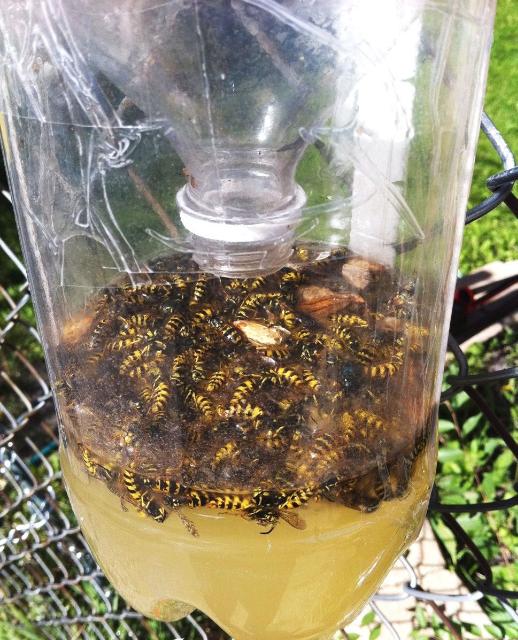
by Beth Bolles | Oct 29, 2018
As Hurricane Michael was barreling through the Panhandle region, wasp populations were at their highest of the year. Winds and flooding destroyed many of the nests of paper wasps, hornets, and yellow jackets and now wasps may be aggressive as they defend themselves or remnants of their nests. All are capable of multiple stings that are very painful. It is very likely that you will encounter stinging wasps as they scavenge for food and water, as well as seek shelter among debris and exposed trash.
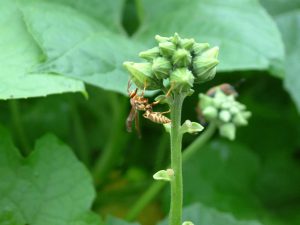
Many people are stung by paper wasps after storms. They are not attracted to traps.
Here are a few pointers to help deal with stinging wasps.
- Try not to swat at wasps flying around or landing on you. You may be less likely to receive a sting if you can flick them off.
- Some wasps are attracted to the sap from broken or recently cut trees. Look before you reach. Wear gloves and other protective clothing when moving debris in case you disturb foraging or nesting activities.
- Wasps are also attracted to sugars and water. Try your best to keep food and drink cans covered. Completely close garbage containers or bags that contain food debris.
- Repellents are not effective against wasps. There are pesticides labeled to spray on smaller paper wasp nests if you find one in a spot close to people’s activity. These are usually aerosol pyrethroids or pyrethrins. Make sure you read the label carefully and use the product as directed.
- Do not use non labeled products like gasoline to manage wasps. This is not only illegal but can be dangerous to yourself and the environment.
- There are traps for yellowjackets that you may purchase or make. These only manage those wasps flying around, not any remaining in a ground nest.
Here is a Do It Yourself Yellowjacket trap from UF IFAS Extension.
- Cut the top 1/3 off your 2 liter bottle so that you have 2 pieces.
- Add a bait (fermenting fruit or beer) to the bottom of the plastic bottle.
- Invert the top portion of the bottle into the base, forming a funnel.
- Hang or place traps so they are about 4 to 5 feet above the ground. For safety, place them away from people.
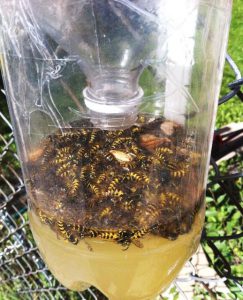
A homemade trap to catch yellowjackets. Photo by Alison Zulyniak
by Mary Salinas | Oct 20, 2018
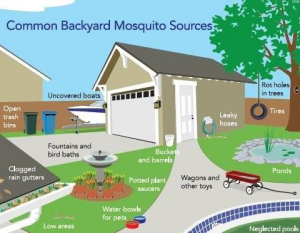
A natural disaster such as Hurricane Michael can cause excess standing water which leads nuisance mosquito populations to greatly increase. Floodwater mosquitoes lay their eggs in the moist soil. Amazingly, the eggs survive even when the soil dries out. When the eggs in soil once again have consistent moisture, they hatch! One female mosquito may lay up to 200 eggs per batch . Standing water should be reduced as mush as possible to prevent mosquitoes from developing.
You should protect yourself by using an insect repellant (following all label instructions) with any of these active ingredients or using one of the other strategies:
- DEET
- Picaridin
- Oil of lemon eucalyptus
- Para-menthane diol
- IR3535
- An alternative is to wear long-sleeved shirts and pants – although that’s tough in our hot weather
- Wear clothing that is pre-treated with permethrin or apply a permethrin product to your clothes, but not your skin!
- Avoid getting bitten while you sleep by choosing a place with air conditioning or screens on windows and doors or sleep under a mosquito bed net.
Now let’s talk about mosquito control in your own landscape.
Let’s first explore what kind of environment in your landscape and around your home is friendly to the proliferation of mosquitoes. Adult mosquitoes lay their eggs on or very near water that is still or stagnant. That is because the larvae live in the water but have to come to the surface regularly to breeze. The small delicate larvae need the water surface to be still in order to surface and breathe. Water that is continually moving or flowing inhibits mosquito populations.
Look around your home and landscape for these possible sites of still water that can be excellent mosquito breeding grounds:
- bird baths
- potted plant saucers
- pet dishes
- old tires
- ponds
- roof gutters
- tarps over boats or recreational vehicles
- rain barrels (screen mesh over the opening will prevent females from laying their eggs)
- bromeliads (they hold water in their central cup or leaf axils)
- any other structure that will hold even a small amount of water (I even had them on a heating mat in a greenhouse that had very shallow puddles of water!)
You may want to rid yourself of some of these sources of standing water or empty them every three to four days. What if you have bromeliads, a pond or some other standing water and you want to keep them and yet control mosquitoes? There is an environmentally responsible solution. Some bacteria, Bacillus thuringiensis ssp. israelensis or Bacillus sphaericus, only infects mosquitoes and other close relatives like gnats and blackflies and is harmless to all other organisms. Look for products on the market that contain this bacteria.
For more information:
Mosquito Repellents
UF/IFAS Mosquito Information Website
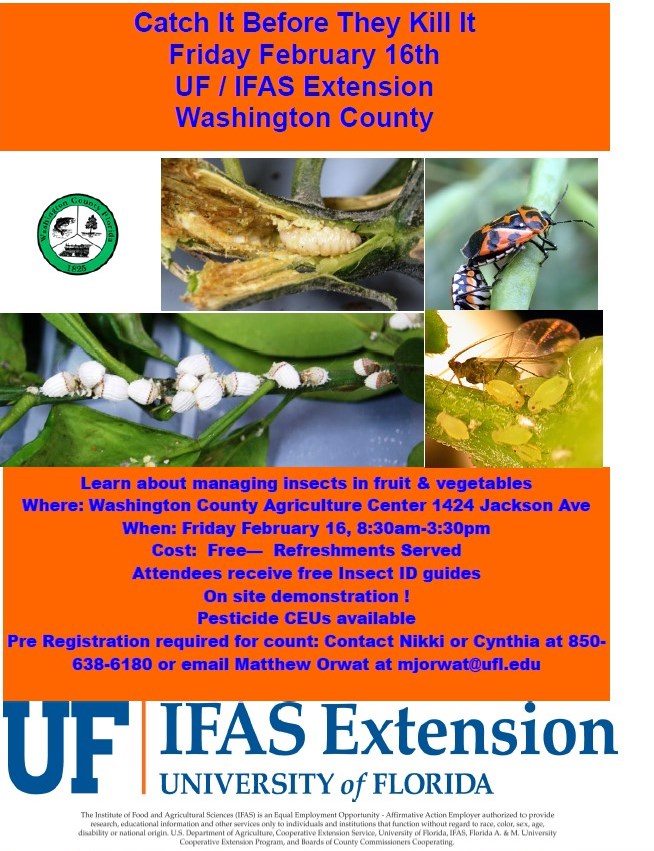
by Matthew Orwat | Jan 23, 2018
Please join us for an informative workshop to learn about managing insects in fruit & vegetables. You will learn how to identify common insect pests, control insect pests and submit samples for diagnosis from University of Florida / IFAS specialists. Attendees will receive free Insect ID guides and participate in an on-site demonstration ! Pesticide CEUs will be available for license holders as well. This workshop Washington County Agriculture Center 1424 Jackson Ave., East wing. it will be Friday February 16, 8:30am-3:30pm and there is no cost. Pre-Registration required for count: Contact Nikki or Cynthia at 850-638-6180 or email Matthew Orwat at mjorwat@ufl.edu

Agenda
Welcome 8:30am-8:35am
Matthew Orwat, Washington County Cooperative Extension
Introduction 8:35am-8:40am
Amanda Hodges, University of Florida
True bugs in Spring Vegetables-Identification and Management 9:00am-10:15am
Amanda Hodges and Ploy Kurdmongkoltham, University of Florida
Cowpea Curculio 10:15am-10:30pm
Ploy Kurdmongkoltham and Amanda Hodges, University of Florida
Break 10:30am-10:45am
Whitefly Management 10:45am-11:10am
Matthew Orwat, Washington County Extension
Importance of Invasive Species to North Florida Vegetable Production 11:10am-11:30am
Amanda Hodges, University of Florida
Invasive Stink Bugs and Related True Bugs 11:30am-11:50pm
Brown Marmorated Stink Bug, Bagrada Bug, and Kudzu Bug
Amanda Hodges, University of Florida
Lunch 11:50pm-12:30pm
Tomato leafminer Tuta absoltua 12:30m-12:45pm
Brad Danner, FDACS-DPI Survey Specialist
Old World bollworm and Exotic Spodoptera Pests 12:45pm-1:05pm
Silvana Paula-Moraes, University of Florida
Common Vegetable Plant Diseases in the Florida Panhandle
curcubits and hands on samples 1:05pm-1:35pm
Sanju Kunwar, University of Florida
Pest and Pathogen Walk 1:35pm-2:05pm
CAPS Exotic Corn Diseases of Concern 2:05pm-2:35pm
Brad Danner, FDACS-DPI Survey Specialist
Sample Submission, Arthropod and Disease samples 2:35pm-2:50pm
Ploy Kurdmongkoltham and Amanda Hodges, University of Florida
Conclusion and Post-Workshop Survey 2:50pm-3:15pm
Amanda Hodges, University of Florida
by Larry Williams | May 11, 2017
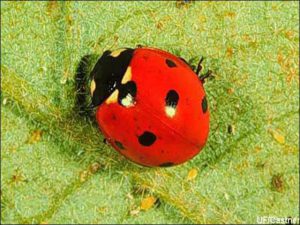
Adult Ladybug. Photo Credit: James Castner University of Florida
A number of summers ago, I noticed whiteflies on a confederate rose plant in my landscape. I considered using an insecticide to control the whiteflies but decided against doing so after taking a closer look. What I found was a population of ladybugs – eggs, larvae, pupae and adults.
Ladybug adults and larvae eat whiteflies, as well as other soft-bodied insects such as aphids. So, I waited to see what would happen.
At first I was seeing mostly adult whiteflies, which look like tiny white moths. Adult whiteflies mate and then lay eggs on the underside of leaves. The eggs hatch into flat translucent scale-like nymphs that suck the “juice” from the underside of the leaves.
Eventually, some of the leaves developed a black coating called sooty mold. As certain insects (primarily aphids, some scales and whiteflies) feed, they excrete plant sap that coats the leaves. Sooty mold then grows on this sugary sap. It’s not a pathogen. It just makes the leaves look ugly.
Knowing that the whiteflies would not kill the confederate rose, I was willing to tolerate the sooty mold and allow the ladybug population to build.
Allowing whiteflies to live on your plants may not always be the best option. But in order to have beneficial insects in your landscape, there must be some “bad” insects for them to eat.
Insects such as ladybugs, lacewings and praying mantises eat many pest insects. Encouraging these beneficial insects can allow you to reduce the amount of pesticides applied.
It’s important to learn to recognize the adult and immature stages of these beneficial insects. Ladybugs have larvae that look nothing like
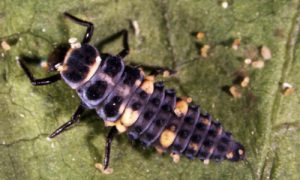
Ladybug larva. Photo credit: Aristizabal University of Florida
the adults. Some ladybug larvae look like small orange and black alligators. Others may resemble mealybugs. Many gardeners that would never kill adult ladybugs mistake their larvae as pests and kill them with insecticides.
The following UF/IFAS Extension website will help you learn to recognize many of our beneficial insects. http://edis.ifas.ufl.edu/topic_beneficial_insects
Once you find beneficial insects in your landscape, reduce or eliminate the use of insecticides. When an insecticide is needed, use environmentally friendly options such as insecticidal soaps, horticultural oils and products that contain Bacillus thuringiensis (Bt).
Sometimes a heavy stream of water from a water hose is all that is needed to remove pest insects from plants and reduce their numbers to an acceptable population.
Remember, leaving a few pest insects is a great way to attract beneficial insects. Tolerating a minor infestation and a little plant damage will benefit the helpful insects, your pocketbook and the environment.
by Matt Lollar | Apr 13, 2017
Most of you plant a spring vegetable garden with a number of different vegetable types. However, you may not realize that you are improving the health of your soil and your crops by planting a diverse garden. Intercropping is a gardening practice of growing different crops in the same field. When planting a mixture of crops in the same field year after year, it is important to rotate the location of each type of vegetable. This is a practice known as crop rotation. Intercropping and crop rotation will help reduce insect pest populations, increase beneficial insect populations, and reduce weed populations.
Crop Diversity
Growing plants in your garden that pest insects don’t like to eat makes the pests work harder to find what they do like to eat. Studies have found reduced whitefly numbers on squash plantings mixed with a crop of buckwheat when compared to squash planted alone. Another crop mixture that may be unintentional, but may work in your favor is a row of crapemyrtles along the edge of your garden. Crapemyrtles will attract the crapemyrtle aphid which will attract predatory insects. When the predatory insects run out of crapemyrtle aphids to eat, they will move to your garden and begin to hunt pest insects on your vegetable crop.

Squash with living mulch of buckwheat. Photo Credit: Oscar Liburd, UF/IFAS Extension
Trap Cropping
A trap crop is a plant that attracts a pest insect away from your food crops. Trap crops work best when planted at the edge of your garden, along a fence row, or in movable containers. A bare space, let’s say 5 feet or so, should be kept between your trap crop and your garden. This will help keep the pests from moving on to your vegetables. When you find a good population of pests on your trap crop then it is time to spray them with insecticide or cut the crop down and remove the debris to a location far from your garden. If your trap crops are planted in containers, then it makes them that much easier to remove from near the garden area.
Cover Crops and Green Manure
Soil organic matter can be increased by the use of green manure and cover crops. Cover crops are generally planted during the off-season, but they can be planted in between vegetable rows and tilled in at a designated time as a green manure. Both cover crops and green manure improve the production of your garden by:
- Suppressing weeds by competing for water, light, and nutrients;
- Holding the soil in place and preventing erosion;
- Scavenging for nutrients that can be utilized in future crops;
- Reducing nematode populations;
- Providing a habitat for beneficial insects.

A mixed plot of cover crops and trap crops. Photo Credit: UF/IFAS Extension
A number of different crops can serve as cover crops or green manure crops. Most are legumes (bean family) or grasses. A few that you might like to give a try are:
- Cowpeas
- Sunn hemp
- Sorghum-sudangrass
- Winter rye
More detailed information on cover crops and green manure can be found at this link: http://edis.ifas.ufl.edu/aa217.









